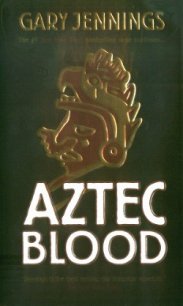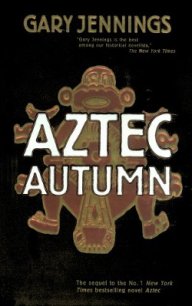Aztec - Jennings Gary (книги хорошем качестве бесплатно без регистрации TXT) 📗
Three or four days on the westering trade road brought us to a village called Zitakuaro, where a guardpost on its outskirts marked the frontier of Michihuacan. There we halted while the Purempecha border guards respectfully scanned the letter I presented, and then only prodded but did not open our various packs. They did look somewhat amazed when they peered into the oversized litter chair and found two identical bald girls riding side by side in what appeared to be a most uncomfortable position. But the guards did not comment. They waved courteously for me and my lady and our party to pass on through Zitakuaro.
After that, we were not again stopped or challenged, but I commanded that the curtains be kept closed on the Lady Pair's litter, so that they should not be visible to the people who eyed our passing. I knew that a swift-messenger would already have informed the Uandakuari of our approach, but I wanted to keep his gift a mystery and undescribed, insofar as possible, until we got to his palace and surprised him with it. Zyanya thought me cruel, to make the twins ride all that way without seeing anything of the new country in which they would live. So, every time I showed her something of interest, she would stop our train until the road was clear of passersby, and then herself go back to lift the twins' curtain and show them whatever it was. She kept doing that all the way across Michihuacan, rather to my exasperation, since Left and Right were utterly apathetic and incurious about their surroundings.
The trip would have been tedious for me had it not been for the presence of Zyanya; I was glad she had persuaded me to let her come. She even made me forget, now and then, the hazardous task I was to undertake at our destination. Every time our train rounded a bend in the road or breasted the crown of a hill, Zyanya would see something new to her, and she would exclaim over it, and listen with childlike intensity as I explained it to her.
The first thing that excited Zyanya's attention, of course, was the preponderance of glossily hairless people. I had told her of that custom, but telling is no substitute for seeing. Until gradually she got used to it, she would stare at a passing youth and murmur, "That one is a boy. No, a girl..." And I must admit that her curiosity was reciprocated. The Purempecha were accustomed to seeing other people unshorn—foreign travelers, their own lower classes, and perhaps stubborn eccentrics—but they had never seen a lovely woman with a wealth of long hair and a vivid white strand streaking through it. So they also stared and murmured.
There were other things to see besides the people. The part of Michihuacan which we were then traversing has mountains, as does every other land, but there they seem always to sit on the horizon as a mere frame for the level or gently rolling country they enclose. Some of that territory is forested, some is grown up in meadows of useless but lovely grass and wild flowers. But much of it consists of wide-spreading, bountifully producing farms. There are immeasurable swales of maize, beans, chilis, orchards of ahuacatin and of sweeter fruits. Here and there in the fields stand the adobe cribs in which seed and produce are stored—conical bins, rather resembling the Lady Pair's tapering heads.
In those regions, even the humblest dwellings are good to look at. All made of wood, since wood is so abundant there, they are put together without mortar or tie ropes but with ingeniously tight notches in the planks and beams. Every house has a high, peaked roof, its eaves deeply overswooping the house all around, the better to give cool shade in the hot season and to shed rain in the wet, and some of the roofs are fancifully made so that their four corners turn upward in perky ornamental points. That was the season of swallows, and there are nowhere more swallows than in Michihuacan—flitting, fluttering, flickering, gliding all about—no doubt because those capacious roof eaves make such fine nesting places for them.
With its woods and waters, Michihuacan is a hospitable home for all sorts of birds. The rivers reflect the bright flashing colors of jays and flycatchers and fisher birds. In the forests the carpenter birds make a constant tattoo of drumming and drilling. In the lake shallows stand big white and blue herons, and the even bigger kuinko. That bird has a bill shaped like a spoon, an ungainly shape, and gawky long legs. But the kuinko is superb in its sunset-colored plumage, and when a flock of them all take wing at once it is like watching the wind made pink and visible.
The single greatest concentration of Michihuacan's population lived in the multitude of villages ringing the big Lake of Rushes, Patzkuaro, or perched on the many small islands in that lake. Although every village derived most of its sustenance from netting the waters' fish and fowl, every village was bidden by the Uandakuari to produce or provide one special, local commodity or service which it traded to all the others. One community made hammered copperware, another wove cloth, another braided rushes into matting, another made lacquerware, and so on. The village named for the lake, Patzkuaro, was the marketplace for those various things. One island in mid-lake, Xarakuaro, was built up with temples and altars, and was the ceremonial center for the residents of every village. Tzintzuntzani, Where There Are Hummingbirds, was the capital and heart of all that activity, so itself produced nothing but the decisions and orders and rulings that governed the whole nation. It consisted entirely of palaces and was entirely inhabited by nobles and their families, their courtiers, priests, servants, and such.
As our train approached Tzintzuntzani, the first man-made object we could see, from several one-long-runs down the road, was the ancient iyakata, as a pyramid is called in Pore, looming on the heights east of the nobles' palaces. Old beyond imagining, not tall but extravagantly elongated, that iyakata—a curious blend of square and round edifices—was still an awe-inspiring pile of stone, though it had long ago lost all its slab sheathing and gesso and coloring, and was much crumbled and overgrown with verdure.
The numerous palaces of Where There Are Hummingbirds, being all built of wood, might have been accounted less imposing than the stone palaces of Tenochtitlan, but they had their own kind of grandeur. Under the spreading eaves of their high-peaked, curly-cornered roofs, they were all two floors high, and the upper floor was completely encircled by an outside gallery. The ponderous cedar trunks upholding those buildings, the columns and banisters, the many beams visible under the eaves, all those things were elaborately worked and carved into curls and fretwork. Wherever artists could reach, the rich lacquers had been laboriously hand-applied. Every palace was lavishly ornamented, glowing with color and gold leaf, but of course the Uandakuari's palace made all the others look trivial.
Swift-messengers had kept Yquingare apprised of our progress, so our arrival was expected, and a crowd of nobles and their ladies waited to receive us. Our company had earlier veered off to the lakeside and, separating for privacy, we had all bathed and changed into our finest garments. We came, feeling fresh and looking proud, into the palace forecourt—a walled garden overhung by tall shade trees—where I ordered the litter chairs set down. I dismissed our guards and bearers, and they were led off to be quartered with the servants. Only Zyanya, the Lady Pair, and myself went on through the garden to the tremendous palace building. In the general confusion of the greeters milling all about us, the twins' odd way of walking went unremarked.
In a welcoming murmur and chatter, not all of which I could comprehend, we were ushered between the palace's cedar-trunk portals onto the cedar-slab terrace, then through the great open door, then through a short corridor and into Yquingare's reception hall. It was immensely long and wide, and two floors high: like the interior court of Ahuitzotl's palace, only roofed over. Stairways on each side climbed to an encircling inside balcony off which the upper rooms opened. The Uandakuari sat on a throne that was only a low chair, but the long walk from the entrance to where he sat was clearly designed to make every visitor feel like a supplicant.




